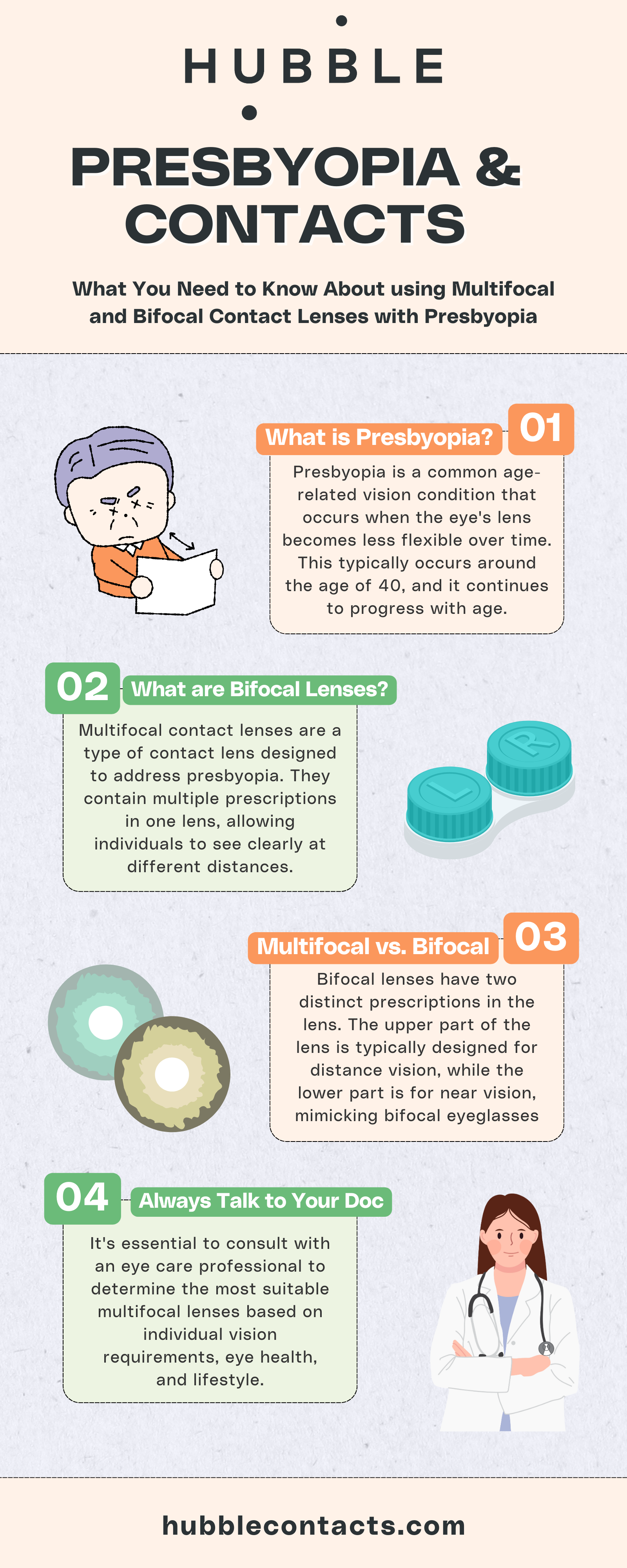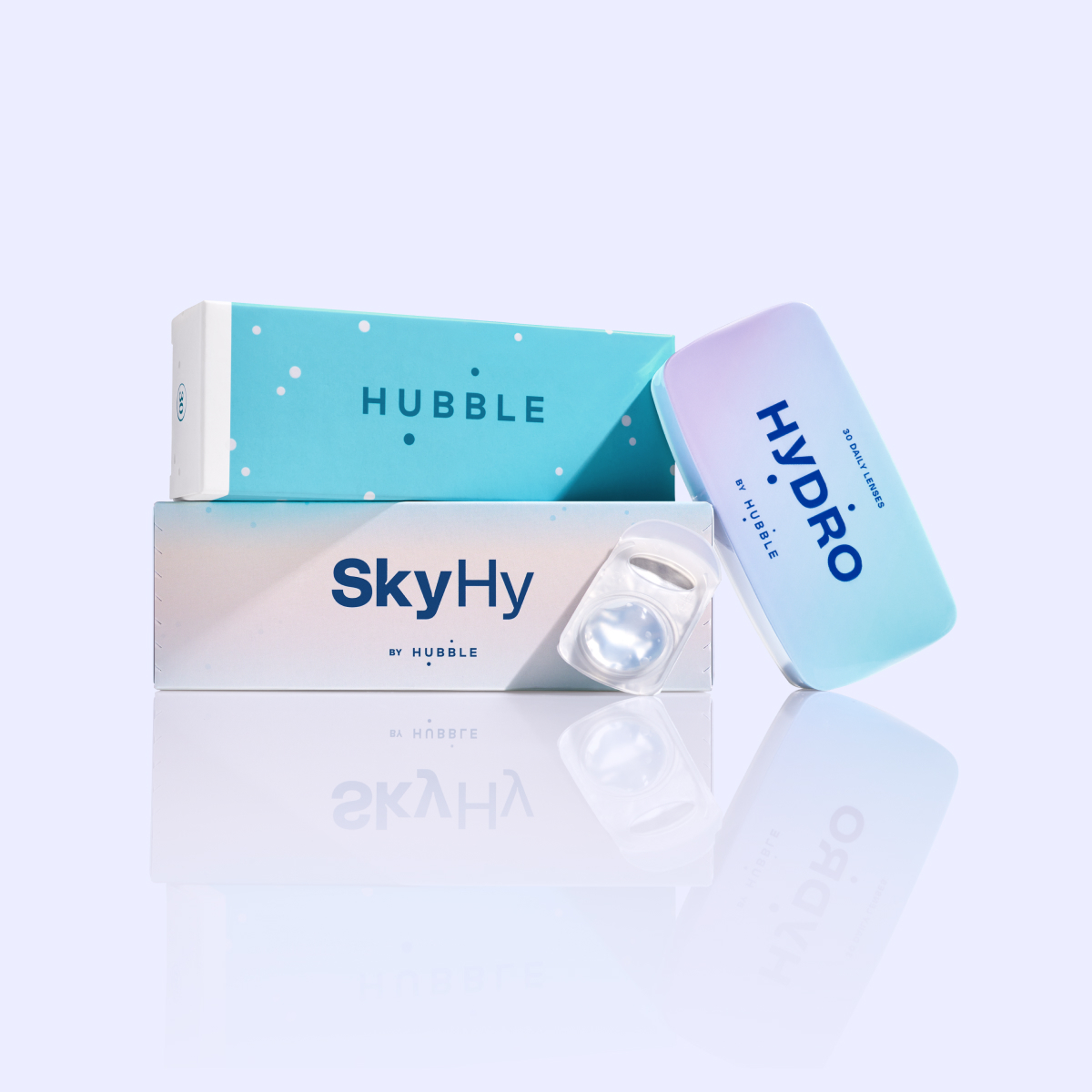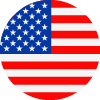Multifocal Contacts: A Solution for Presbyopia

As humans age, one of the inevitable conditions that come with living longer is the natural development of presbyopia, a condition where eyesight changes and vision becomes a challenge for up-close reading.
As a contact lens user, incorporating a range of prescriptions to cover various distances, multifocal lenses can help with clarity of vision. Multifocal prescription contact lenses feature three zones: distance, intermediate (for tasks like computer use), and near vision. Some multifocal lenses use a gradual transition between these zones, providing a more seamless experience for vision at different distances.
What is Presbyopia
Presbyopia is a common age-related vision condition that occurs when the eye's lens becomes less flexible over time. This typically occurs around the age of 40, and it continues to progress with age. The flexibility of the lens is crucial for focusing on objects at different distances.
As the eye’s lens loses its flexibility, it becomes challenging for the eye to focus on close-up objects, such as when reading or doing other tasks that require near vision. The ability to accommodate or adjust the focus between near and distant objects diminishes, leading to difficulties with tasks that require clear close-up vision.
The symptoms of presbyopia include:
- Difficulty reading small print or performing tasks at close range.
- The need to hold reading material at arm's length to see it clearly.
- Eye strain or headaches after performing close-up tasks for an extended period.
Presbyopia is a natural part of the aging process and affects nearly everyone to some degree. It is not a disease, and it can be corrected with the use of reading glasses, bifocals, or progressive lenses.
What Are Multifocal Contact Lenses?
Multifocal contact lenses are a type of contact lens designed to address presbyopia, the age-related condition that makes it difficult to focus on close-up objects. These lenses contain multiple prescriptions in one lens, allowing individuals to see clearly at different distances, including near, intermediate, and far.
Multifocal contact lenses differ from standard single-vision contacts in their design and purpose. While standard contact lenses correct vision for a specific distance (either nearsightedness or farsightedness), multifocal contact lenses are designed to provide clear vision at multiple distances, addressing the effects of presbyopia.
Here's how multifocal contact lenses work, how they differ from standard contacts, and how their unique design allows for clear vision at various distances:
Multiple Prescriptions in One Lens
Standard Contacts - Single-vision prescription contacts have a consistent prescription power across the entire lens. They correct refractive errors for either nearsightedness (myopia) or farsightedness (hyperopia), but they don't address presbyopia.
Multifocal Contacts - Multifocal lenses have two or more prescriptions within the same lens. This allows wearers to see clearly at different distances, typically covering near, intermediate, and distance vision.
Bifocal or Progressive Design
Bifocal Contacts - Some multifocal lenses have a bifocal design, similar to bifocal eyeglasses. There are distinct zones for near and distance vision, separated by a visible line.
Progressive Contacts - Other multifocal lenses use a progressive design, with a gradual transition between the prescription zones. This provides a more seamless visual experience as wearers shift their gaze between near and distant objects.
Distance, Intermediate, and Near Vision Zones
Distance Vision Zone - The upper part of the lens is designed for distance vision, allowing wearers to see clearly at a distance, such as when driving or watching TV.
Intermediate Vision Zone - The middle part of the lens is for intermediate vision, addressing tasks like working on a computer or reading at arm's length.
Near Vision Zone - The lower part of the lens is for near vision, facilitating activities like reading a book or looking at a smartphone.
Adapting to Different Prescriptions
Adjustment - The eye learns to adapt to the different prescriptions within the lens, automatically adjusting focus based on the wearer's visual needs at the moment.
Learning Curve - Some wearers may experience a short adaptation period as their eyes and brain learn to coordinate and switch between the various prescription zones. SkyHy by Hubble contact lenses ensures a snug fit to mold to the curve of your eye. As one of the softest lenses available, SkyHy by Hubble provides high-level comfort and a gentle touch to overcome this learning curve.
How Do Multifocal Contacts Work?

Multifocal contact lenses provide wearers with the flexibility to perform a range of tasks without the need for additional reading glasses or bifocals. The specific design of multifocal lenses allows wearers to enjoy clear vision at different distances, making them a practical solution for individuals with presbyopia.
Some common technologies used in multifocal contact lenses:
Bifocal Design
Some multifocal contact lenses have a bifocal design, similar to bifocal eyeglasses. This design includes two distinct prescription zones in the lens—one for distance vision and one for near vision. The transition between these zones is often marked by a visible line.
Progressive Design
Other multifocal lenses use a progressive design, which is characterized by a gradual transition between different prescription powers. Unlike bifocals with a visible line, progressive multifocal lenses have a seamless progression from the distance prescription to the near prescription.
Simultaneous Vision Technology
Multifocal lenses use a concept called simultaneous vision, where the various prescriptions for different distances are present in the lens simultaneously. This allows wearers to see clearly at different distances by relying on their eyes and brain to automatically adjust focus.
Optimized Add Power
The "add power" refers to the additional prescription power needed for near vision correction. Multifocal lenses are designed with optimized add power to ensure clear and comfortable near vision without compromising distance vision.
Multifocals vs. Bifocals: Understanding the Difference
Bifocal lenses have two distinct prescriptions in the lens. The upper part of the lens is typically designed for distance vision, while the lower part is for near vision. This design mimics the setup of bifocal eyeglasses. Multifocal lenses have more than two prescription powers within the same lens, allowing wearers to see clearly at different distances. They often have three zones: distance, intermediate, and near vision. Some use a gradual transition between these zones (progressive design).
Bifocal prescription contacts follow a more traditional design, similar to bifocal eyeglasses. Multifocal prescription contact lenses transitions between different prescription powers are typically smooth and gradual, providing a more seamless experience when shifting focus between distances. In bifocals, however, The two prescription powers are clearly segmented, making it easy for wearers to identify the specific zone for distance or near vision.
Advantages and Drawbacks of Multifocal Lenses
When considering the use of multifocal contact lenses, there are several advantages offered:
Freedom from Reading Glasses - Multifocal contacts eliminate the need for carrying or constantly switching between reading glasses and distance glasses.
Convenience - Multifocal contact lenses provide a convenient solution for people who want clear vision at various distances without the use of separate eyeglasses.
Natural-Looking Vision: Unlike traditional bifocal or trifocal glasses, multifocal contact lenses offer a more natural appearance, as there are no visible lines or segments on the lenses.
With the use of multifocal contact lenses, there can be cons or drawbacks such as:
- Adaptation Period -Some multifocal lens wearers may experience a short adaptation period as their eyes and brain adjust to the different prescription zones within the lens. During this time, individuals may notice variations in vision or depth perception.
- Visual Distortions - Certain wearers may experience mild visual distortions, such as halos or glare, especially in low-light conditions.
- Cost - Multifocal contact lenses can be more expensive than single-vision lenses. Additionally, the cost may be higher if you choose custom or specialized designs.
Why Multifocal Contacts Are Ideal for Daily Wear
Crisp vision and visual acuity can be achieved by wearing daily contacts with multifocal lenses, an excellent choice to maximize comfort and practicality. Using contact lenses that have a higher water content provides more comfort for individuals and thus less blurriness. Your eye care professional can guide you on the optimal moisture content. In general, contact lenses with higher water content can be more comfortable for dry eyes, as they are better at retaining moisture.

Choosing the Right Multifocal Lenses for Your Needs
It's essential to consult with an eye care professional to determine the most suitable multifocal lenses based on individual vision requirements, eye health, and lifestyle. Your eye care professional can discuss the potential cons of multifocal contact lens prescriptions and address any concerns you may have based on your circumstances. Regular follow-up appointments are also important to ensure ongoing eye health and optimal lens performance.
Hubble's Commitment to Vision Solutions at Every Age with Contact Lenses Online
Hubble Contacts is dedicated to providing eye care solutions throughout all stages of life, and to help individuals manage presbyopia through a wide selection of bifocal and multifocal contacts sold by our sister site, ContactsCart.
Hubble Contacts is committed to combining quality, comfort, and advanced technology in our contact lenses online. Experience our range of comfortable and affordable contact lenses with the convenience of our signature customizable subscription service. Your eyes are unique, and your lenses should be too. With FDA-approved lenses and a user-friendly approach, Hubble Contacts is here to provide you with clear and comfortable vision for less
At Hubble, we aim to be the one-stop destination for all of your vision needs, including contact lenses, Frames by Hubble as well as eye care accessories. With Hubble, your contact lens subscription arrives on time with recurring orders so you never run low. Try our affordable dailies and learn more about our convenient contact subscription offerings.



